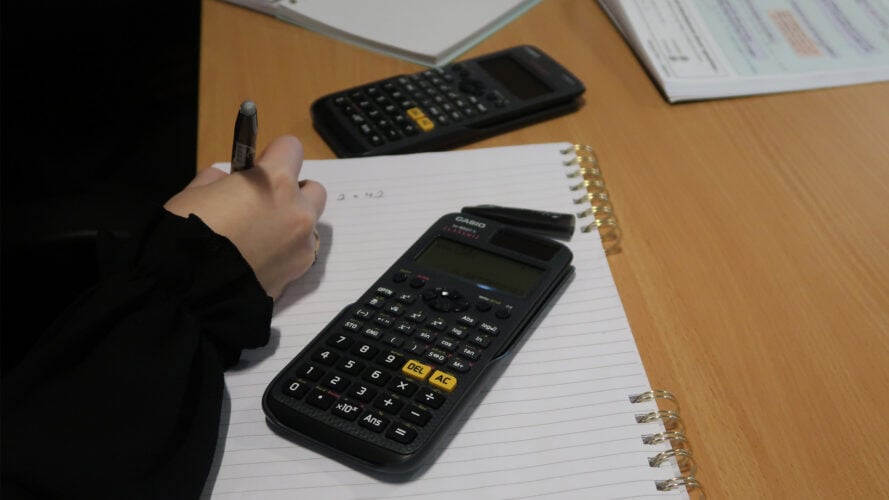Bidding adieu to an old favourite: mastering the ClassWiz calculator before the upgrade

As the exam season approaches, students are gearing up to face the ultimate academic challenge: the Math exams. One tool that has become an indispensable companion for students during this time is the ClassWiz calculator. While the new ClassWiz range is already out, most will be heading into this year’s exams with the older model simply because there’s no time to get acquainted with the new range. There’s no need to worry, though, says Math expert Simon May. The much-loved, older ClassWiz range is tried and tested, and when aware of some handy features and functionalities, your students can tackle any exam question that comes their way. In this article, Simon walks you through them.
First things first
A fresh start
During a Maths exam, the handset should be a help, not a burden. Therefore, Simon recommends setting the calculator to its default settings by resetting it, which can be done by pressing `Shift` and then `9 (Reset)`. This then gives three main options to choose from. Clearing the memory will erase all the variables, including “M values”, etc. While it’s also possible to select the “Setup Data” option, Simon recommends going with “Initialise All”, which will delete all the data and setup configurations and put the handset in its default state, which gives students a clean slate.
Your handset, your way
Students can personalise the handset by pressing `Shift` and then `Setup`. For example, the type of input and output can be changed as needed. It’s important to select the correct option from fractions and decimals because sometimes, students need the accuracy of fractions. Fractions give exact values, while decimal numbers can cause errors due to rounding.
In the available options, the “MathI/MathO” option means fractions in, fractions out, and “MathI/DecimalO” means fractions in, decimals out. Simon says: “The default MathI/MathO option is interesting because it presents values such as surds exactly as they are, without simplifying them into mere decimals.”
Get your units of measure in line
Another point worth noting is the correct usage of radian and degree mode. Simon recommends choosing “Radians” for advanced-level exams because most questions use this unit of measure. For example, a popular question at the advanced level is integrating a trig function such as y=sin(x). If the student has chosen the degrees mode, the answer will be incorrect. The currently selected mode can be determined by the letter at the top of the screen where “D” is for degrees and “R” is for radians.
Numbers and accuracy
To adjust the level of precision in their answers, students can simply change the “Number Format” setting. By selecting the “Fix” option in the Number Format setting, students can fix their answers to a specific number of significant figures. However, it’s important to keep in mind that this rounding-off process may introduce further errors in later calculations. In most exams, three significant figures are expected. Here, the default “Norm” option will give the answer up to ten decimal places.
Menu is where things are at
Different modes
Students can use the Menu option to choose the calculator’s mode. One interesting one is the “Equation/Function” mode, where equations can be solved quickly.
Students can simply plug the required values into the equations to solve polynomial equations like quadratics, cubics, and quartics. Students can use the keypad arrows to scroll the answers when there are multiple answers. The arrow icons at the top of the screen show the user that multiple answers are available.
Solve it easily
One alternative way to solve equations is using the “Calculate” mode. For instance, if students need to solve an equation like ![]() , they can use the “solve” option on their calculator. To access this option, they simply need to press “Shift” and then “Solve”. The calculator will then prompt the student for an approximate answer to arrive at the solution quickly. Simon says: “If you used a graphic calculator, this step would be very straightforward because you can see how the function behaves.” He adds: “If a student needs a more elaborate answer instead of just a single decimal numerical value, the equation solver option can be used instead.”
, they can use the “solve” option on their calculator. To access this option, they simply need to press “Shift” and then “Solve”. The calculator will then prompt the student for an approximate answer to arrive at the solution quickly. Simon says: “If you used a graphic calculator, this step would be very straightforward because you can see how the function behaves.” He adds: “If a student needs a more elaborate answer instead of just a single decimal numerical value, the equation solver option can be used instead.”
Variables are your friend
Multiple variables can be stored in the memory of the fx-991EX handset. These can be used almost anywhere where a numerical value is expected. An interesting feature of this handset (and of many of its kind) is the ability to reuse the value of a variable for which an equation has been solved. For example, a student can reuse the value of “x” mentioned in the above section in subsequent calculations.
Additionally, students can access the answer to their most recent calculation by pressing the “Ans” button on their calculator. What’s more, they can assign this value to a system variable (such as A, B, x, or y) by using the “STO” button and then pressing the button corresponding to the relevant variable.
Stat it!
An essential part of Mathematics for advanced level is Statistics. Numerous statistical functions are available in the ClassWiz handset, like 1-variable tables and bi-variate data support.
Another highly beneficial feature of the fx-991EX calculator is the “Distributions” menu. This menu supports popular distributions such as normal and binomial distributions. Students will likely rely heavily on the “Normal CD” and “Inverse Normal” options for advanced-level exams. However, practising using the Binomial PD and Binomial CD options before the exam is also advisable, as they can be incredibly valuable in certain contexts and can be calculated from lists or variables.
One popular example where the Binomial CD option can be used is in the well-known “coin toss” problem. For instance, if a student needs to determine the probability of obtaining heads less than four times when flipping a coin ten times, they would need to enter the value of x as 4, N as 10, and a value for “p”. If the coin is unbiased (with an equal probability of getting heads and tails), then the value of “p” would be 0.5.
Get ready for the new Classwiz range
The tried and tested ClassWiz is a much-loved calculator by both students and professors and has proven to be an excellent choice for various applications, from basic arithmetic to advanced calculus.
While bidding farewell to the old Classwiz model, we’re excited to introduce the new fx-991CW calculator set to take students’ mathematical experience to the next level. The new fx-991CW calculator has features that help make Maths more interactive and engaging for students. For instance, students can now visualise expressions and solutions from the calculator on any internet-capable smartphone or tablet through ClassPad.net. Moreover, the calculator features new key labels that clearly represent each function and feature. Additionally, students can access a robust library of mathematical functions presented in both app and catalogue formats. Want to learn more about our new Classwiz range? Check it out here.



